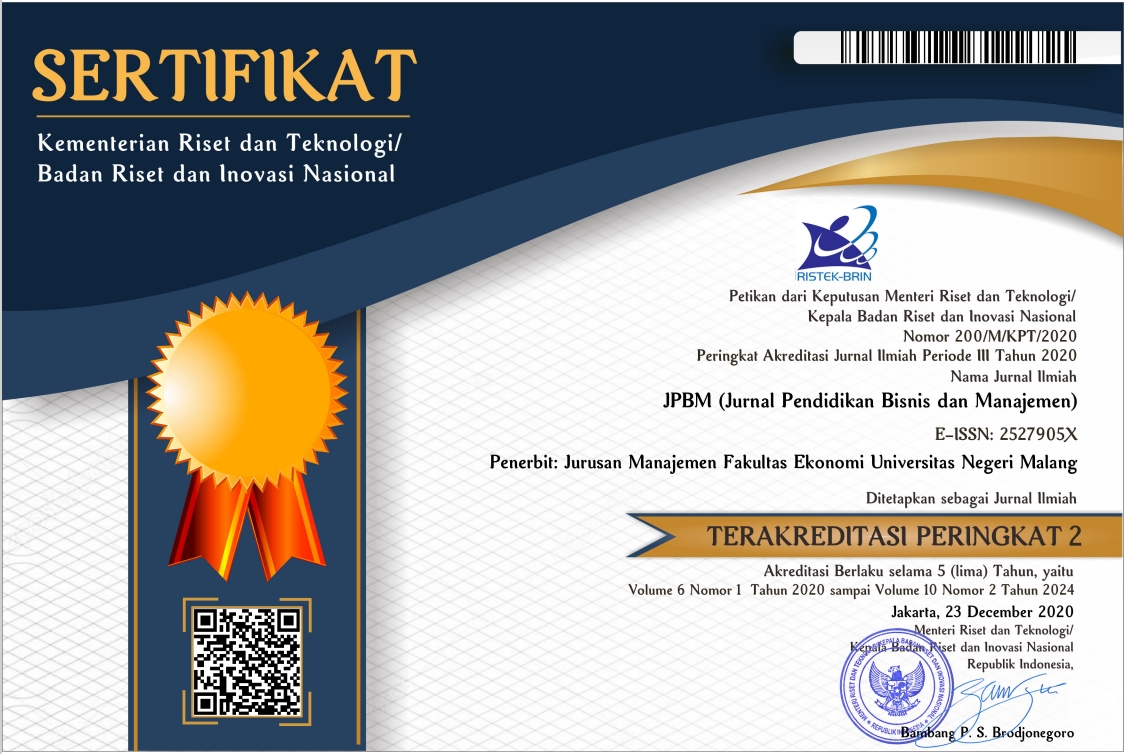Factors Affecting Live Streaming Commerce Purchase Behavior
Abstract
Online shopping provides various benefits to customers, but it has a fundamental limitation, which is direct interaction with the product. The growth of live streaming commerce (LSC) is a new way for people to reduce their concerns in online shopping. This study identifies the factors that can influence purchase intention in LSCs. The present study used a quantitative approach. The population of this study is all Indonesians who have shopped in LSC in which a sample of 102 respondents was obtained through online distribution of a questionnaire. The data was analyzed descriptively and through Partial Least Square Structural Equation Modelling (PLS-SEM). The results of this study show that physical characteristic similarity has a significant effect on product fit uncertainty. Value similarity has a significant effect on trust. Access to online information has a significant effect on trust but not purchase intention. Trust has a significant influence on product uncertainty and purchase intention. Likewise, product uncertainty has a significant effect on purchase intention. Price has a significant effect on hedonic motivation but not purchase intention. Hedonic motivation has no significant effect on purchase intention. E-commerce platforms and merchants who utilize LSCs can use the findings in this study to improve their business.
Keywords: Live streaming commerce, Product uncertainty, Purchase intention, TikTok
Full Text:
PDFReferences
Alzoubi, H., Alshurideh, M., Kurdi, B., Alhyasat, K., & Ghazal, T. (2022). The effect of e-payment and online shopping on sales growth: Evidence from banking industry. International Journal of Data and Network Science, 6(4), 1369-1380.
Appel, G., Grewal, L., Hadi, R., & Stephen, A. T. (2020). The future of social media in marketing. Journal of the Academy of Marketing science, 48(1), 79-95.
Ardiansyah, F., & Sinduwiatmo, K. (2023). TikTok sebagai media personal branding melinda rohita. Jurnal Pustaka Komunikasi, 6(1), 1-12.
Arnold, M. J., & Reynolds, K. E. (2003). Hedonic shopping motivations. Journal of Retailing, 79(2), 77-95.
Çebi Karaaslan, K. (2022). Determinants of online shopping attitudes of households in Turkey. Journal of Modelling in Management, 17(1), 119-133.
Certal, V., de Lima, F. F., Winck, J. C., Azevedo, I., & Costa-Pereira, A. (2015). Translation and cross-cultural adaptation of the Pediatric Sleep Questionnaire into Portuguese language. International Journal of Pediatric Otorhinolaryngology, 79(2), 175-178.
Cheng, X., Gu, Y., & Shen, J. (2019). An integrated view of particularized trust in social commerce: An empirical investigation. International Journal of Information Management, 45, 1-12.
Cuesta-Valiño, P., Gutiérrez-Rodríguez, P., & Durán-Álamo, P. (2022). Why do people return to video platforms? Millennials and centennials on TikTok. Media and Communication, 10(1), 198-207.
Forsythe, S., Liu, C., Shannon, D., & Gardner, L. C. (2006). Development of a scale to measure the perceived benefits and risks of online shopping. Journal of Interactive Marketing, 20(2), 55-75.
Fu, S., Yan, Q., & Feng, G. C. (2018). Who will attract you? Similarity effect among users on online purchase intention of movie tickets in the social shopping context. International Journal of Information Management, 40, 88-102.
Guo, L., Hu, X., Lu, J., & Ma, L. (2021). Effects of customer trust on engagement in live streaming commerce: mediating role of swift guanxi. Internet Research, 31(5), 1718-1744.
Hair, J. F., Black, W. C., Babin, B. J., Anderson, R. E., Black, W., & Anderson, R. (2019). Multivariate data analysis (Eighth). Cengage Learning EMEA.
Hajli, N. (2020). The impact of positive valence and negative valence on social commerce purchase intention. Information Technology & People, 33(2), 774-791.
Hidayat, A., Wijaya, T., Ishak, A., & Endi Catyanadika, P. (2021). Consumer trust as the antecedent of online consumer purchase decision. Information, 12(4), 145.
Hong, Y., & Pavlou, P. A. (2014). Product fit uncertainty in online markets: Nature, effects, and antecedents. Information Systems Research, 25(2), 328-344.
Hruska, J., & Maresova, P. (2020). Use of social media platforms among adults in the United States—behavior on social media. Societies, 10(1), 27.
Hu, M., & Chaudhry, S. S. (2020). Enhancing consumer engagement in e-commerce live streaming via relational bonds. Internet Research, 30(3), 1019-1041.
Jin, S. V., Muqaddam, A., & Ryu, E. (2019). Instafamous and social media influencer marketing. Marketing Intelligence & Planning, 37(5), 567-579.
Kang, K., Lu, J., Guo, L., & Li, W. (2021). The dynamic effect of interactivity on customer engagement behavior through tie strength: Evidence from live streaming commerce platforms. International Journal of Information Management, 56, 102251.
Khare, A., Dixit, S., & Sarkar, S. (2020). Antecedents to online travel purchase: Role of network benefits, pilgrimage packages, interactivity, trust and customer reviews. Journal of Quality Assurance in Hospitality & Tourism, 21(6), 690-715.
Kim, S., & Eastin, M. S. (2011). Hedonic tendencies and the online consumer: An investigation of the online shopping process. Journal of Internet Commerce, 10(1), 68-90.
Kuswanto, H., Pratama, W. B. H., Ahmad, I. S., & Salamah, M. (2019). Analysis of students’ online shopping behaviour using a partial least squares approach: Case study of Indonesian students. Cogent Business & Management, 6(1), 1699283.
Lu, B., & Chen, Z. (2021). Live streaming commerce and consumers’ purchase intention: An uncertainty reduction perspective. Information & Management, 58(7), 103509.
Luo, J., Ba, S., & Zhang, H. (2012). The effectiveness of online shopping characteristics and well-designed websites on satisfaction. Mis Quarterly, 1131-1144.
Ming, J., Jianqiu, Z., Bilal, M., Akram, U., & Fan, M. (2021). How social presence influences impulse buying behavior in live streaming commerce? The role of SOR theory. International Journal of Web Information Systems, 17(4), 300-320.
Mohan, M. D., Muthaly, S., & Annakis, J. (2015). Talent culture’s role in talent development among academics: insights from Malaysian government linked universities. TheJournal of Contemporary Issues in Business and Government, 21(1), 46-71.
Moon, J., Choe, Y., & Song, H. (2021). Determinants of consumers’ online/offline shopping behaviours during the COVID-19 pandemic. International Journal of Environmental Research and Public Health, 18(4), 1593.
Nanda, A., Xu, Y., & Zhang, F. (2021). How would the COVID-19 pandemic reshape retail real estate and high streets through acceleration of E-commerce and digitalization? Journal of Urban Management, 10(2), 110-124.
Padmavathy, C., Swapana, M., & Paul, J. (2019). Online second-hand shopping motivation–Conceptualization, scale development, and validation. Journal of Retailing and Consumer Services, 51, 19-32.
Román, S., & Ruiz, S. (2005). Relationship outcomes of perceived ethical sales behavior: the customer's perspective. Journal of Business Research, 58(4), 439-445.
Santo, P. E., & Marques, A. M. A. (2021). Determinants of the online purchase intention: Hedonic motivations, prices, information and trust. Baltic Journal of Management, 17(1), 56-71.
Siegrist, M., Cvetkovich, G., & Roth, C. (2000). Salient value similarity, social trust, and risk/benefit perception. Risk Analysis, 20(3), 353-362.
Sun, Y., Shao, X., Li, X., Guo, Y., & Nie, K. (2020). A 2020 perspective on “How live streaming influences purchase intentions in social commerce: An IT affordance perspective”. Electronic Commerce Research and Applications, 40, 100958.
Tsimonis, G., & Dimitriadis, S. (2014). Brand strategies in social media. Marketing Intelligence & Planning, 32(3), 328-344.
Vijayasarathy, L. R., & Jones, J. M. (2000). Print and Internet catalog shopping: Assessing attitudes and intentions. Internet Research.
Wang, Y., Lu, Z., Cao, P., Chu, J., Wang, H., & Wattenhofer, R. (2022). How live streaming changes shopping decisions in E-commerce: A study of live streaming commerce. Computer Supported Cooperative Work (CSCW), 1-29.
Wicaksono, A. (2022, 05 Oktober 2022). Kirim barang beda dari pesanan, akun TikTok Shop dilarang melapak lagi. https://www.cnnindonesia.com/teknologi/20221005154217-206-856728/kirim-barang-beda-dari-pesanan-akun-tiktok-shop-dilarang-melapak-lagi
Wolfinbarger, M., & Gilly, M. C. (2001). Shopping online for freedom, control, and fun. California management review, 43(2), 34-55.
Wongkitrungrueng, A., & Assarut, N. (2020). The role of live streaming in building consumer trust and engagement with social commerce sellers. Journal of Business Research, 117, 543-556.
Xu, P., Cui, B.-j., & Lyu, B. (2022). Influence of streamer's social capital on purchase intention in live streaming E-commerce. Frontiers in Psychology, 12, 6194.
Xu, X., Wu, J.-H., & Li, Q. (2020). What drives consumer shopping behavior in live streaming commerce? Journal of Electronic Commerce Research, 21(3), 144-167.
DOI: http://dx.doi.org/10.17977/um003v9i32023p201
Refbacks
- There are currently no refbacks.
JPBM (Jurnal Pendidikan dan Bisnis Manajemen) is licensed under a Creative Commons Attribution-NonCommercial-ShareAlike 4.0 International License.
JPBM (Jurnal Pendidikan dan Bisnis Manajemen) is abstracted and indexed in :

















